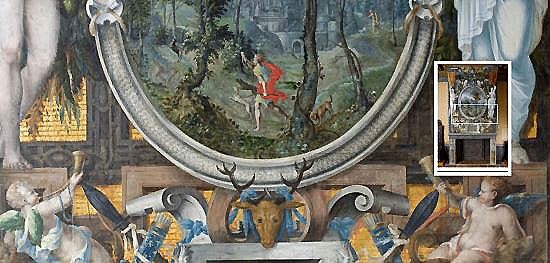Diana's Bath by Francois Clouet, court painter, toward vers 1565 / zoom with analysis.
The three goddesses were real rivals, Catherine de Medici (with the black cloth as the widow of Henri II), Diane de Poitiers, Henri's favorite (her colors, black and white) and Marie de Guise (Scottish, as shown by the thistle, queen after Henri's death and member of the hostile, Catholic Guise clan). The satyres are Guise leaders. The horseman is a hunter with his dog, who will kill them.
The painting was commissioned by a Protestant nobleman at the court against Catholic rivals, a few years before the massacre of Protestants by Catholics.
# # #
The style characterizes mansions and chateaux:
- The mansion of the Minister of Finance (toward 1630):
- Mantels, the most prestigious sites of glacial chateaux:
- At Écouen* Jacob sins, leaves, returns and is forgiven, like the owner** who offends Diane de Poitiers, leaves the court and eventually reconciles with the king.
*Now the Renaissance Museum, north of Paris.
Esau's Hunt, museum publication
- At Condé en Brie (in Champagne) a god carries off a woman. The work alludes to the owner* making a married woman his mistress as Louis XIV had done with Madame de Montespan (before he knew of her visits to the witch) and imitates a Versailles statue.
*The Marquis de la Faye, private secretary to Louis XIV
 |
Claude Abron Château de Condé - Aymeri de Rochefort; Pluto Carries off Prosperine by François Girardon, toward 1690, Versailles / zoom |
Madame de Montespan
chose the story of Helen of Troy
as decor for her chateau.
-- Athénaïs, the Real Queen of France by Lisa Hilton, 2002









No comments:
Post a Comment